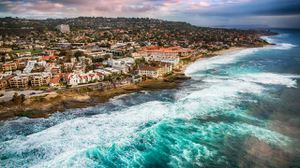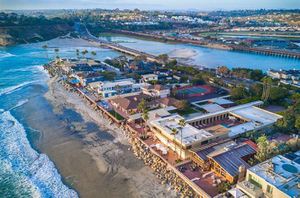About La Jolla, CA
With a dramatic coastline boasting incredible views, it's no surprise that La Jolla is one of the most popular beach destinations in California. Surrounded on three sides by the sea and backed by the steep slopes of Mt. Soledad, La Jolla's natural beauty, abundance of activities and upscale village lifestyle ensure that it lives up to its nickname as "the jewel" of San Diego.
La Jolla is a hilly, seaside community within the city of San Diego, California, occupying 7 miles (11 km) of curving coastline along the Pacific Ocean within the northern city limits. The population reported in the 2010 census was 46,781.
La Jolla is surrounded on three sides by ocean bluffs and beaches and is located 12 miles (19 km) north of Downtown San Diego and 40 miles (64 km) south of Orange County. The climate is mild, with an average daily temperature of 70.5 °F (21.4 °C).
La Jolla is home to many educational institutions and a variety of businesses in the areas of lodging, dining, shopping, software, finance, real estate, bioengineering, medical practice and scientific research. The University of California San Diego (UCSD) is located in La Jolla, as are the Salk Institute, Scripps Institution of Oceanography (part of UCSD), Scripps Research Institute, and the headquarters of National University (though its academic campuses are elsewhere).
La Jolla offers a wide range of accommodations from luxurious hotels to casual coastal retreats, along with museums and art galleries, one-of-a-kind boutiques, great restaurants and a slew of outdoor activities. Home to the famous Torrey Pines Golf Course and The Lodge at Torrey Pines, the scenic cliff area offers well-groomed hiking trails with spectacular views, and world-class golf. At Torrey Pines Gliderport you can soar out over the beach cliffs on a hang glider or just relax and watch the action above.
Along the dramatic coastline lies Scripps Park, where families can picnic throughout the summer, while enjoying Fourth of July fireworks and concerts under the stars. Just south of the park is the Children’s Pool, where a seawall was originally built to protect kids from incoming waves, but has been long taken over by a local seal colony. People are no longer permitted to swim here, but you can walk out along the seawall for a close-up view of the wildlife.
La Jolla is also home to Birch Aquarium at Scripps Institute of Oceanography and plenty of cultural attractions including the La Jolla Playhouse and the Museum of Contemporary Art, all situated in close proximity to The Village. The University of California San Diego, which hosts the popular Geisel Library and the Salk Institute for Biological Studies, are both located in La Jolla as well.
La Jolla's biggest draw for locals and visitors alike are the beautiful beaches. During the summer and autumn months, the surf is relatively gentle, with warm waters in 70s. Swimmers, snorkelers, scuba divers, kayakers and surfers can enjoy the golden sands of La Jolla Shores, the Cove and Windansea. And be sure to keep an eye out for migrating whales off the coast as they travel to and from Baja California.
According to United States Census Bureau figures, the ethnic/racial makeup of La Jolla is 82.5% White, 0.8% Black, 0.2% American Indian, 11.2% Asian, 0.1% Pacific Islander, 2.0% some other race, and 3.1% two or more races. Latinos, who may be of any race, form 7.2% of La Jolla's population.
Local Native Americans, the Kumeyaay, called this location mat kulaaxuuy (IPA: [mat kəlaːxuːj]), lit. "land of holes". The topographic feature that gave rise to the name "holes" is uncertain; it probably refers to sea-level caves located on the north-facing bluffs, which are visible from La Jolla Shores. It is suggested that the Kumeyaay name for the area was transcribed by the Spanish settlers as La Jolla. An alternative, pseudo-etymological suggestion for the origin of the name is that it is an alternate spelling of the Spanish word la joya, which means "the jewel". Despite being disputed by scholars, this derivation of the name has been widely cited in popular culture. This supposed origin gave rise to the nickname "Jewel City".
Early history
During the Mexican period of San Diego's history, La Jolla was mapped as pueblo land and contained about 60 lots. When California became a state in 1850, the La Jolla area was incorporated as part of the chartered City of San Diego. In 1870, Charles Dean acquired several of the pueblo lots and subdivided them into an area that became known as La Jolla Park. Dean was unable to develop the land and left San Diego in 1881. A real estate boom in the 1880s led speculators Frank T. Botsford and George W. Heald to further develop the sparsely settled area.
In the 1890s, the San Diego, Pacific Beach, and La Jolla Railway was built, connecting La Jolla to the rest of San Diego. La Jolla became known as a resort area. To attract visitors to the beach, the railway built facilities such as a bath house and a dance pavilion. Visitors were housed in small cottages and bungalows above La Jolla Cove, as well as a temporary tent city erected every summer. Two of the cottages that were built in 1894 still exist: the "Red Roost" and the "Red Rest", also known as the "Neptune and Cove Tea Room"; the two cottages have been vacant since the 1980s, and are covered in tarpaulins. The La Jolla Park Hotel opened in 1893. The Hotel Cabrillo was built in 1908, was later incorporated into the La Valencia Hotel.
The La Jolla Beach and Yacht Club (later the La Jolla Beach and Tennis Club) was built in 1927.
About Del Mar, CA
Del Mar Village
Del Mar is a quaint seaside village rich in history, striking natural beauty and European charm. Located just 20 miles north of San Diego on the Southern California coastline, Del Mar Village is unique in its offering of a vibrant small-town atmosphere, sprawling natural playground along the Pacific Ocean and the casual sophistication of a world-class destination.
First renowned during the golden era of the movie industry, Del Mar was the retreat for Hollywood’s biggest movie stars who came to enjoy its peaceful ambiance, pristine beaches, and exhilarating thoroughbred horseracing. Today, the affluent and historic Del Mar Village attracts visitors from across the globe seeking breathtaking vistas, stunning sandstone canyons, beach activities and award-winning cuisine with spectacular ocean views.
The collection of unique, independent shops, outdoor cafes and boutique hotels, many in half-timbered, Tudor-style buildings, is accessible on foot throughout the heart of the Village. Del Mar Village is also easily navigated on a bicycle and the beaches are dog-friendly.
Del Mar is home to the renowned Del Mar Racetrack which brings the excitement of thoroughbred horseracing during racing season and the hugely popular San Diego County Fair which kicks off the start of summer. Nearby attractions include famed Torrey Pines Golf Course, home to the US Open and Farmers Insurance Open, the world-famous San Diego Zoo and Safari Park, Torrey Pines State Preserve and Legoland.
Del Mar is a beach city in San Diego County, California. Del Mar is Spanish for "of the sea" or "by the sea," which reflects its location on the coast of the Pacific Ocean. The Del Mar Horse Races are hosted on the Del Mar racetrack every summer. The United States Navy operated a Naval Auxiliary Air Facility for blimps at Del Mar during World War II. The population was estimated at 4,311 in 2014, up from 4,161 at the 2010 census.
According to the United States Census Bureau, the city has a total area of 1.8 square miles (4.7 km2). 1.7 square miles (4.4 km2) of it is land and 0.1 square miles (0.26 km2) of it (3.94%) is water. At the southern edge of Del Mar is the Los Peñasquitos Lagoon.
Del Mar is also one of few locations in which the Torrey Pine tree grows. The Torrey Pine is the rarest pine in the United States and only two populations of this endangered species exist. The Soledad Valley at the south of Del Mar severs two colony segments of the Pinus torreyana.
The 2010 United States Census reported that Del Mar had a population of 4,161. The population density was 2,341.9 people per square mile (904.2/km²). The racial makeup of Del Mar was 3,912 (94.0%) White, 10 (0.2%) African American, eight (0.2%) Native American, 118 (2.8%) Asian, three (0.1%) Pacific Islander, 25 (0.6%) from other races, and 85 (2.0%) from two or more races. Hispanic or Latino of any race were 175 people (4.2%).
Del Mar Facts
Del Mar is Spanish for “of the sea” or “by the sea,” which reflects its location on the coast of the Pacific Ocean.
The City of Del Mar was incorporated in 1959 and is the smallest incorporated city in San Diego County, with a population of 4,500 tucked into 2.1-square-miles.
Del Mar’s climate is considered Mediterranean-subtropical with warm, dry summers and mild, humid winters. It is considered one of the most desirable climates in the United States. Temperatures rarely exceed 85 °F (29 °C) or drop below 41 °F (5 °C) throughout the year. The average yearly temperature in Del Mar is approximately 65 °F (18 °C).
History of Del Mar
In 1882, a New Yorker named Theodore Loop came to Southern California to build a railroad connecting Los Angeles and San Diego. The original train tracks were laid down in the middle of Township 14, known today as Del Mar. Mr. Loop liked the area so much he told people that he had “found the most attractive place on the entire coast.”
In the same year, Loop met a very successful rancher from New Mexico, Mr. Jacob Shell Taylor. Taylor and Loop were both captivated by the beauty of the area and recognized a development opportunity. In the summer of 1885, Taylor purchased 338.11 acres and began building the new resort town.
Del Mar was named by Loop’s wife, Ella, who took it from a popular poem of the time titled “The Fight for Paso Del Mar.” Jacob Taylor initially built as many as 40 small houses, a two story Victorian schoolhouse, an observation tower, a train depot and a water system. Additionally, in 1886 Taylor opened “Casa Del Mar,” the area’s first resort. Del Mar became a popular vacation destination.
For five years, the town bustled with development. Sadly in 1889 Jacob Taylor woke up in the early morning to the smell of smoke in his hotel room. He woke the hotel guests, guaranteeing their safety, but within two hours the entire hotel burned to the ground. Taylor insisted he would rebuild the hotel but, unfortunately, he never finished it. Taylor moved to Texas; leaving behind the town he founded, never to return.
The Big Boom
Over 15 years lapsed before the next development boom. In 1900, the South Coast Land Company purchased the majority of land north of 9th Street. Like Taylor, the directors of the South Coast Land Company had big plans for Del Mar. Their first project was the grand resort hotel called the “Stratford Inn”. They hired a prominent Los Angeles architect, John C. Austin. The new hotel was built on the hill overlooking the beach. (Today the L’Auberge hotel occupies this land.)
On March 9, 1909, the beautiful Stratford Inn opened for business. It was a world-class hotel built on 10 acres. It quickly became the desired destination for Hollywood’s silent film stars. Shortly after the hotel was finished, a pier (which was washed away in a storm years later) and a new train depot were built. The train depot was directly in front of the hotel, making it an easy commute. The same depot sits on the location today.
During the 20′s and 30′s Del Mar experienced tremendous growth.
The Racetrack and Fairgrounds
During the early 30′s the San Diego Fair was looking for a permanent home. Col. Ed Fletcher of the South Coast Land Company suggested the 184-acre site in the San Dieguito Valley just north of the Village. The Works Progress Administration provided the initial funding and the Del Mar Fair opened to great fanfare in 1936, a yearly tradition that continues.
A year after the Fair opened the mile-long oval thoroughbred racetrack was completed.
During World War II the races came to a halt so that the facilities could be used as a bomber tail assembly plant. However, racing returned in August 1945 after Japan surrendered.
Del Mar Historic Walking Tour
Now, it’s possible to learn about the Village of Del Mar’s rich history through a pleasant walking tour, a perfect way to spend a sun-soaked day in North County San Diego’s prestigious and already walkable seaside city
About Rancho Santa Fe, CA
The population was 3,117 at the 2010 census. The CDP is primarily residential with a few shopping blocks, a middle and elementary school, and several restaurants.
History
In 1841, Rancho San Dieguito, as it was originally named, was a Mexican land grant of 8,824 acres (35.71 km2) from Governor Pío Pico of Alta California to Juan Maria Osuna, the first alcalde (mayor) of the Pueblo of San Diego.
In 1906, the Santa Fe Railway, a subsidiary of the Atchison, Topeka & Santa Fe Railway, purchased the entire land grant to plant a Blue gum eucalyptus (Eucalyptus globulus) tree plantation for use as railroad ties, but the wood proved too soft to hold railroad spikes. The railroad then formed the Santa Fe Land Improvement Company to develop a planned community of country estates, and 6,200 acres developed from the original Rancho San Dieguito land grant were renamed "Rancho Santa Fe" in 1922.
In 1921, architect Lilian Rice, working under Requa and Jackson, was chosen to develop the community's master plan. Rice worked through to 1927, designing, supervising, and constructing the village center, as well as several homes. The basics of the original Lilian Rice land plan are in effect to this day, and the resulting low density high green space community is unique in Southern California.
In 1923, the Santa Fe Land Company constructed a guest house called "La Morada" to house potential land purchasers. It was renamed in 1941, as "The Inn", when it was purchased by a private owner.
In 1989, "The Covenant" of Rancho Santa Fe was registered as California Historical Landmark #982 for its status as a historic planned community.
According to the United States Census Bureau, the CDP has a total area of 6.8 square miles (18 km2). 6.7 square miles (17 km2) of it is land and 0.1 square miles (0.26 km2) of it (1.07%) is water.
Rancho Santa Fe has a warm-summer Mediterranean climate.
The climate for the most part, typical of the San Diego metropolitan area though its higher elevation and inland location lends itself to larger temperature variations.
The 2010 United States Census reported that Rancho Santa Fe had a population of 3,117. The population density was 459.2 people per square mile (177.3/km²). The racial makeup of Rancho Santa Fe was 2,910 (93.4%) White, 10 (0.3%) African American, 1 (0.0%) Native American, 87 (2.8%) Asian, 4 (0.1%) Pacific Islander, 45 (1.4%) from other races, and 60 (1.9%) from two or more races. Hispanic or Latino of any race were 176 persons (5.6%).
I hope you liked the information about my favorite areas f San Diego County.


